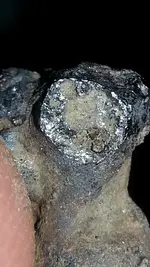Upvote
1
You are using an out of date browser. It may not display this or other websites correctly.
You should upgrade or use an alternative browser.
You should upgrade or use an alternative browser.
how do you identify metals
- Thread starter berti
- Start date
Plumbata
Bronze Member
Well, you can test the hardness of the metal or alloy with a knife, then you can weigh it with an accurate scale, and then with a graduated cylinder or measuring beaker perform a water displacement test to determine the rough density (grams per cubic centimeter) of the item. You can also test it with Hydrochloric acid and Nitric acid, etc, to rule-out (or in) certain metals further. I'm not sure if I am looking at a strange mineral specimen (such as Galena / Lead Sulphide, which is very dense/heavy), or pyrite/chalcopyrite pictured in odd light, or a blob of amorphous Zinc melted in a fire years ago, or...?
Asking how to "identify metals" is like asking someone to transcribe the Encyclopedia Britannica. If it is an unpaid request no one will trouble themselves with the gargantuan task. It would be much more productive if you provided some useful details to narrow down the realm of inquiry a bit.
Asking how to "identify metals" is like asking someone to transcribe the Encyclopedia Britannica. If it is an unpaid request no one will trouble themselves with the gargantuan task. It would be much more productive if you provided some useful details to narrow down the realm of inquiry a bit.
Davers
Gold Member
- Joined
- Jan 8, 2013
- Messages
- 8,217
- Reaction score
- 7,277
- Golden Thread
- 0
- Location
- N.of , I-285...GA
- Detector(s) used
- Whites Spc xlt & Tesoro Tejon- Now back ...Fisher 1266-X. TRX Pointer. New .Teknetics G2 + . New AT Pro .
- Primary Interest:
- All Treasure Hunting
It's a bit$@ esp, with alloys ,I wish we all could afford one of those hand held [zappers] that they use at my local recycling yard. Brass , copper ,lead ,pure cast aluminium can be pretty strait forward but as I said other alloys [ not so easy]
MUD(S.W.A.T)
Gold Member
- Joined
- Apr 15, 2005
- Messages
- 8,003
- Reaction score
- 898
- Golden Thread
- 0
- Location
- Location: Undisclosed
- Detector(s) used
- I use, Whites MXT and Garrett AT Pro.
- Primary Interest:
- All Treasure Hunting
Lots of way's you can tell.... Copper is red when scratched, lead turns white after awhile, Aluminum is really lite, Iron is magnetic, silver and gold won't corrode... Water displacement tests and acid tests are good too. You pick up these things and learn them as you go !!
Keep @ it and HH !!
Keep @ it and HH !!
Similar threads
- Suggestion
- Replies
- 7
- Views
- 807
Users who are viewing this thread
Total: 1 (members: 0, guests: 1)





